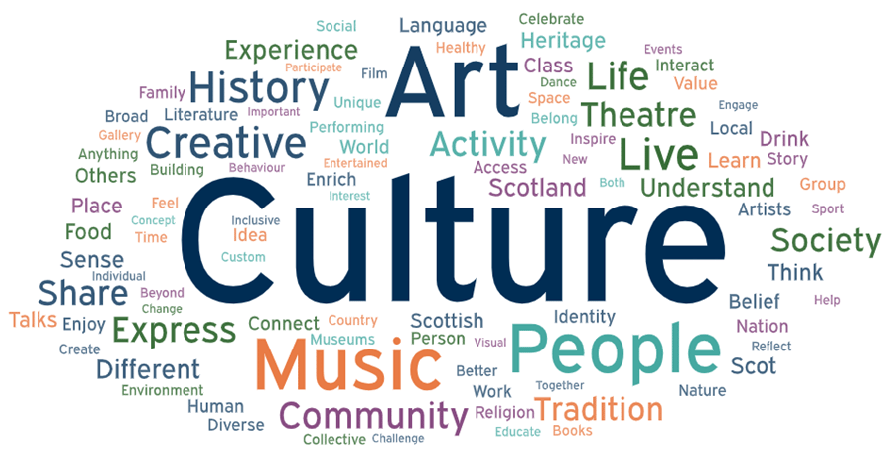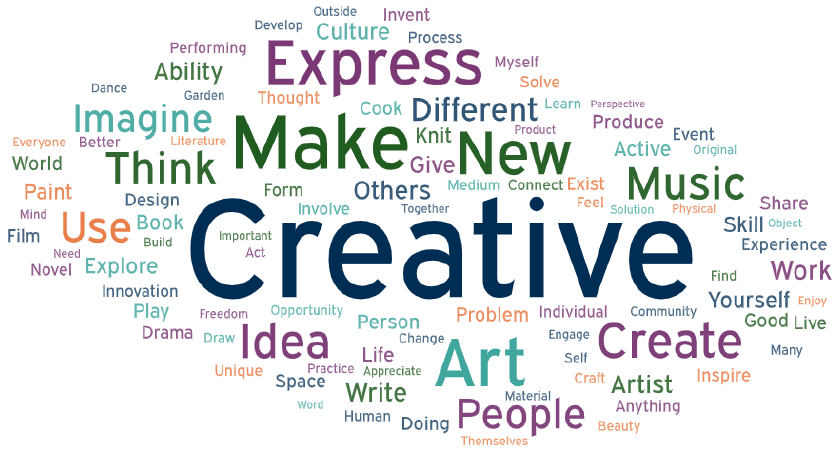Cultural engagement in Scotland: insights from people's experiences
This report provides insights into people's experiences and perceptions of culture and creativity. It draws on data from an online 'free-text' survey that was designed to provide wider context to the data that is available through the Scottish Household Survey.
Section 2: What do ‘culture’ and ‘creativity’ mean to you?
Culture defined
Scottish Government gathers data on culture through the Scottish Household Survey (SHS) to understand the types of activities people enjoy. However, because SHS gives respondents a list of activities and places to choose from, it limits what is cultural, which may not best reflect people’s cultural life. Therefore, to understand more about what culture looks and feels like, a question in the survey asked: ‘what does culture mean to you?’ The responses are visualised in a word cloud below (Figure 4).

The survey received rich responses which have been synthesised under the following themes:
- culture makes life meaningful
- culture broadens horizons
- culture connects people to each other
- culture helps maintain tradition & identity
- culture is inseparable to everyday life
Culture makes life meaningful
Respondents described the idea that culture is ‘essential’, ‘vital’, provides ‘enrichment of the soul’ and core to a healthy, thriving society. Culture can also provide purpose and meaning to people’s lives.
“Whether people understand the term or not, there is not one person in Scotland who does not read, or watch Tv, or listen to music or knit or cook or garden, or watches films or TikTok posts, who plays an instrument or draws or paints or visits museums or who tells stories. It is the stuff of living.” (Female, 45-54)
Culture broadens horizons
Culture can provide exposure to new perspectives and celebrate diversity. It can be educational, reflective and transformative.
“It means the freedom to explore life, to take yourself out of the everyday grind, to gain better understanding of world events through a multitude of lenses, It is an escape, but also a tool to better understand myself, my feelings, my actions. It makes me a better version of myself.” (Female, age band not stated)
“It means diversity. It means equity of access to a variety of experiences whether that be culinary, entertainment, or traditional festivals.” (Female, 55-64)
Culture connects people to each other
Another common response was about sharing and the exchange of ideas, artefacts and joy, whether that be through music, books, the natural world, or simply talking to one another.
“As an immigrant with dual heritage, culture means the ways I can express myself and ways I can connect with people from different walks of life.” (Female, 25-34)
Some described how culture can be two things at once: familiar and new, individual and social.
“It means a sense of identity, belonging and connection. It's something you can feel both very familiar and comfortable with and something that is new, exciting and different.” (Female, 55-64)
Culture helps maintain tradition and identity
Many responses were about heritage, tradition, community identity and belonging. This was often place-specific, linked to where we are from and the environments we live in. Sometimes this is related to the natural world, as well as people. Some respondents described culture as something that is inherited or that we absorb through our surroundings or upbringing.
“My roots, music, language and song, history and lived experience - culture passed down from parents - folk tales, folk music and religion.” (Female, 65-74)
Many answered in terms of Scotland-specific cultural traditions, citing: ceilidhs, folk music, craft, highland games, Gaelic language, song, poetry, oral tradition and humour. There was reference to local cultural Festivals and a shoutout to unique Scottish culture – for example, surrealist visual art, folklore - and cultural exports such as comedy (with comment that this is not always given as much status as other mediums such as theatre and opera).
“Kilts and bagpipes and tartan and Nessie and sporting failure and see-you-Jimmy hats and accordions and fiddles and harps and Red Clydeside and UCS posh frocks and cheap wine and canapes and experts droning on // but really, stuff folk like doing that gives a sense of belonging and collectivity, so defined by class and ethnicity and locality as much as taste.” (Male, 65-74)
This spanned local and national histories: from practices and traditions through to industry. Respondents stated that Scottish culture includes ship building, old financial services, Highland Clearances, as well as storytelling, myths and legends.
“It’s also in our crafting traditions in textiles, wood, ceramic, classical musicianship.” (Female, 65-74)
Local culture is also a ‘way of being’, specific to the environment someone is in:
“In Glasgow there’s a culture of banter, humour and almost aggressive friendliness.” (Male, 45-54).
“I live in the Western Isles. Culture here is anything to do with Gaelic music and a Cèilidh.” (Female, 55-64)
Culture is inseparable to everyday life
This theme brings out the idea that culture is diffuse - it is everywhere, in everything. It was put forward by respondents in challenge to assumptions that culture is something that you ‘go to’ and is separate to everyday life.
Rather, these respondents emphasised that culture is threaded through our everyday: from how we get dressed in the morning, how we speak, what we eat – simply: how we live.
“It's going to concerts and festivals and revelling in everyone enjoying the same things. It's going to a regular pub quiz, its music, it's in everything.” (Female, 25-34)
“I like it when it all mashes together, and sport and leisure mixes up with reading and conversation. I think events like the Olympics can be good for bringing that sense of physical and artistic culture together, for example.” (Male, 45-54)
What or who gets to be considered cultural?
Some respondents discussed who culture is for or who gets to enjoy cultural life, how certain cultural areas are seen to be exclusive or gate-kept, or how people may self-exclude and think it is not for them (as also discussed in the social and psychological barriers section).
“I think it is or perhaps more accurately should be - a term that has a wide meaning but I think the term is often understood, or perceived to mean ‘high’ culture, something unattainable something expensive even, something ‘not for the likes of us’ whereas in fact most arts companies in Scotland are bursting a gut to keep access open to encourage a wide participation. I’m not sure how we can change this perception.” (Female, 85 plus)
There was some commentary surrounding what Government policy conceives of as ‘cultural’ and how this may not reflect most people’s experience of culture, which may be more encompassing.
“I think when used by government it means arts, music and traditions. I often use it as a way to describe a lifestyle so where I live there's a real outdoor culture as well as a creative culture as many artists live here.” (Female, 55-64)
Creativity defined
To understand more about what creativity looks and feels like, respondents were also asked: ‘what does the term “creativity” mean to you?’ The responses are visualised in a word cloud below (Figure 5).

The main themes are:
- Originality
- Active doing
- Free-thinking
- Self-expression
- Going against the grain
- Part of the everyday
Originality
The most common answer was around originality or uniqueness. These respondents described creativity as making something new and/or the ability to transform something.
“Creativity means making something out of nothing, using your imagination and adapting things, inventing things and ending up with something that either didn't exist before or in some way makes life better and more enjoyable.” (Female, 45-54)
Active doing
For others, creativity was less about being original and more about the act of doing something; about the process rather than an end result.
“Creativity is when people get the chance to do things they choose to. It's not necessarily about total freedom of expression, for example, I feel creative when I've exactly followed a knitting pattern without much independent idea making myself. I don't think the creativity is reserved only for the person who wrote the pattern.” (Female, 25-34)
“For people with PMLD [profound and multiple learning difficulties] creativity is about the process of creativity as much as the end product. Creating opportunities for them within their communities in way that they relate to whether that be through art, crafts, music, drama, multi-sensory storytelling, outdoor activities. It is the journey through the process of creativity that is important to people with PMLD.” (Organisation response from PAMIS, a charity that supports people with profound and multiple learning difficulties and their carers.)
Free-thinking
Other common responses described creativity as a way of free-thinking; ‘to be flexible and open-minded’. To think in terms of ‘possibilities’, use one’s imagination and make connections – simply, ‘thinking outside of the box’.
“Creativity is finding freedom and adjusting to the moment vs. being rigid. Creativity is seeing connections.” (Female, 35-44)
Similarly, creativity to some means experimentation: ‘trying things’ or ‘letting our inner child explore ideas’:
“Playful self-expression that is uncensored” (Female, 55-64)
Going against the grain
For some respondents, creativity goes further than expressing themselves. It a response to their surroundings and about challenging expectations.
“Pushing the boundaries of our dominant cultural norms.” (Female, 55-64).
“…challenging and provoking the status quo. It is about renewal and adding richness to life for the individual and society.” (Female, 35-44)
Self-expression
Creativity can be a source of ‘happiness’ and passion, central to individuals’ sense of self. These responses described how creativity gives people agency and is essential to their self-expression. This also brought focus to the wider personal benefits creativity can bring, such as providing relief from life’s challenges and helping build confidence.
“It [creativity] also helps give me a purpose to get up every day. As my movement is restricted outdoors... I would go mad if I hadn't any crafts to do.” (Female, 65-74)
Part of the everyday
In the same way that some respondents saw culture as inseparable to everyday life, some respondents viewed creativity in the same way. Moreover, these respondents see creativity as part of being human.
“Creativity is the beating heart running through all humans - everyone is and can be creative.” (Female, 55-64)
There was repeated mention around children being inherently creative, but that people lose their creative confidence as they age. It was suggested that some people consign themselves to ‘not being creative’. Others challenge that we are all creative.
“I think everyone has it in them to be creative. Look at any child enjoying scribbling on a piece of paper, singing & dancing or getting dressed up. As we grow up, our education system doesn't reward creativity and sucks the joy out of our enjoyment of art & literature... So people grow up not seeing the value in culture/creativity or believing that it is for them.” (Female, 55-64)
“Children are naturally creative, but the world and our environment doesn't always nurture this.” (Female, 35-44)
Contact
Email: socialresearch@gov.scot
There is a problem
Thanks for your feedback